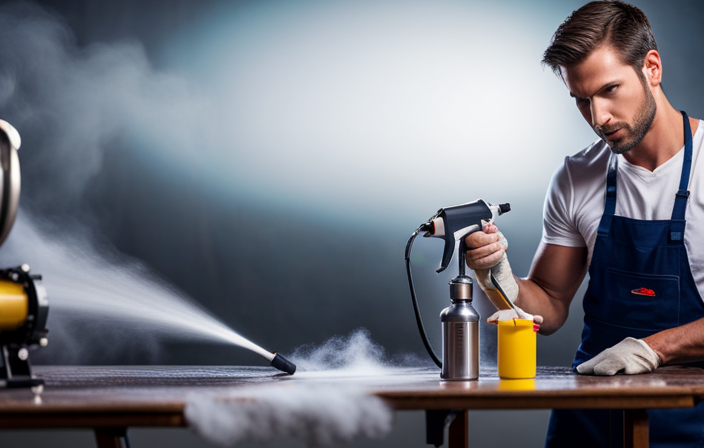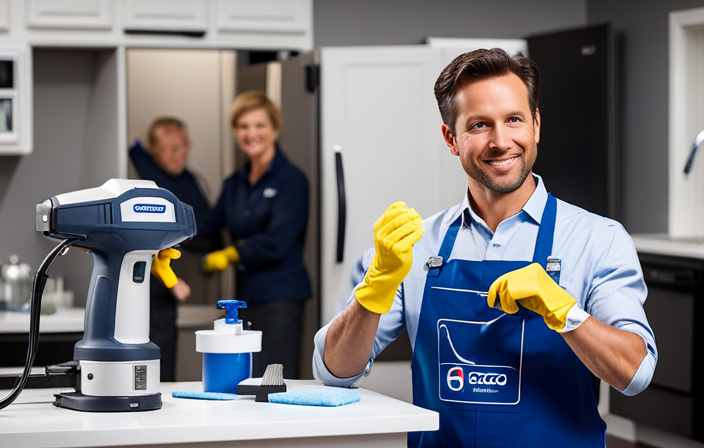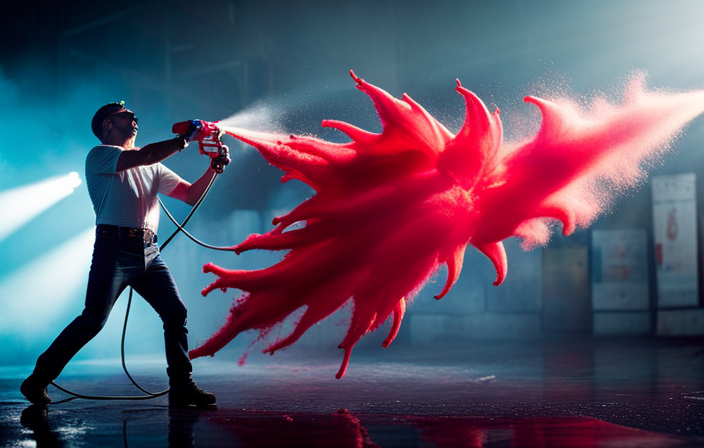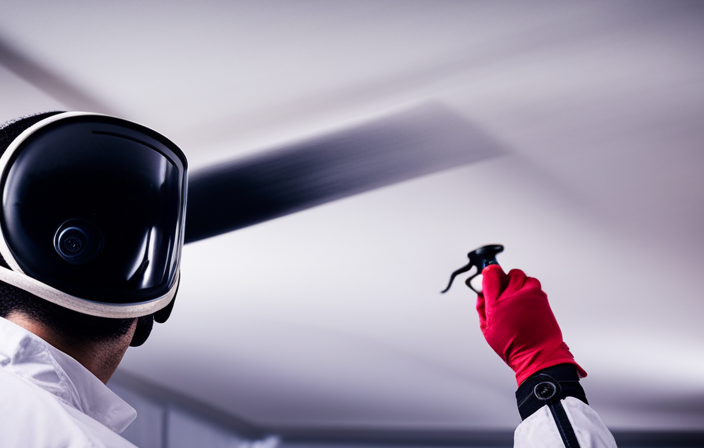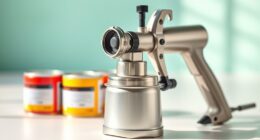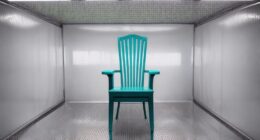Just finished a big painting project and now you have a dirty airless paint sprayer? Don’t worry, I’m here to assist.
In this article, I will show you how to clean a dirty airless paint sprayer with ease.
Cleaning an airless paint sprayer might seem like a daunting task, but with the right tools and techniques, it can be a breeze. By following a few simple steps, you can ensure that your sprayer stays in top condition, ready for future use.
First, gather all the necessary cleaning supplies.
Then, disconnect the sprayer from the power source and release any remaining pressure.
Remove the spray tip and filter, and flush the sprayer with water or a cleaning solution.
Use a brush or toothpick to remove any stubborn paint residue.
Rinse the sprayer thoroughly, dry it, and reassemble it.
Finally, store it in a clean and dry area.
So let’s get started and get that dirty airless paint sprayer looking brand new again.
Key Takeaways
- Pay attention to hard-to-reach areas to prevent moisture buildup
- Thoroughly dry and reassemble the sprayer to prevent damage or malfunction
- Carefully reassemble the sprayer after drying, ensuring snug fit of all parts
- Regularly clean filters and nozzles to prevent clogging
Gather the necessary cleaning supplies
Now, you’re gonna wanna gather all the necessary cleaning supplies to get that airless paint sprayer sparkling clean. Cleaning techniques are important, but before you can even begin, you need to make sure you have the right tools.
Start by grabbing a bucket or container that can hold the cleaning solution. You’ll also need a clean cloth or sponge for wiping down the sprayer. Don’t forget to grab some gloves to protect your hands from the cleaning solution.
As for choosing the right cleaning solution, you want to make sure it’s compatible with the paint you were using. Look for a mild detergent or a specific cleaning solution made for airless paint sprayers.
Once you have everything you need, you can move on to the next step of disconnecting the sprayer from the power source.
Disconnect the sprayer from the power source
First, make sure you’ve unplugged the machine from the power source. This is an essential step in ensuring your safety while cleaning the airless paint sprayer. Cleaning precautions should always be taken to avoid any accidents or injuries.
Once the sprayer is disconnected, you can proceed with the cleaning process. It’s important to follow the manufacturer’s maintenance tips to ensure the longevity of your sprayer. Regular cleaning and maintenance will also guarantee optimal performance.
Now that the sprayer is safely disconnected, the next step is to release any remaining pressure in the sprayer. This will prevent any unexpected spray or splatter when disassembling and cleaning the different parts of the sprayer.
Release any remaining pressure in the sprayer
Before you proceed, make sure all pressure has been released from the sprayer to prevent any unexpected spray or splatter. To safely release pressure in an airless paint sprayer, follow these precautions:
- Wear protective gloves and goggles to shield yourself from any accidental paint spray.
- Position the sprayer outlet away from yourself and others to avoid any potential harm.
- Slowly turn the pressure relief valve counterclockwise to release the pressure gradually.
- Allow any remaining paint or fluid to drain from the sprayer before proceeding.
Double-check that the pressure gauge reads zero before continuing.
Taking these precautions will help prevent any accidents or mishaps while releasing pressure in an airless paint sprayer.
Once all the pressure has been safely released, you can move on to the next step of removing the spray tip and filter.
Remove the spray tip and filter
To safely continue, it’s time to take off the spray tip and filter. This step is crucial in the cleaning process of your airless paint sprayer.
Start by unscrewing the spray tip counterclockwise using a wrench or pliers. Be careful not to damage the tip or the threads.
Once the spray tip is removed, you’ll find the filter located inside the gun handle. Gently pull out the filter and inspect it for any clogs or debris. If necessary, clean the filter using water or a cleaning solution. Cleaning techniques may vary depending on the type of filter, so refer to the manufacturer’s instructions for specific maintenance tips.
With the spray tip and filter removed, we can now move on to flushing the sprayer with water or a cleaning solution.
Flush the sprayer with water or cleaning solution
Once you’ve removed the spray tip and filter, it’s time to give your sprayer a refreshing cleanse by flushing it with water or a cleaning solution. It’s just like giving your car a much-needed wash to remove all the dust and grime. Cleaning a paint sprayer can be done using either water or a cleaning solution. Using water is a more cost-effective option, as it’s readily available and easy to use. However, a cleaning solution specifically designed for paint sprayers can provide a more thorough and effective clean, removing any stubborn residue or paint buildup. The choice between water and cleaning solution ultimately depends on the level of dirt and paint on your sprayer.
After flushing the sprayer, it’s important to clean the filter and spray tip separately to ensure optimal performance.
Clean the filter and spray tip separately
Now, let me show you how you can give your filter and spray tip the attention they deserve to ensure flawless performance.
Cleaning the filter and spray tip is crucial for maintaining the efficiency of your airless paint sprayer. Start by removing the filter and rinsing it with water to remove any loose paint particles. For stubborn residue, you can use a cleaning solution specifically designed for airless paint sprayers. Scrub the filter gently with a brush to remove any clogs or build-up.
Next, move on to the spray tip. Unscrew it from the sprayer and soak it in a cleaning solution for a few minutes. Use a small brush to remove any paint residue that might be blocking the openings.
Rinse both the filter and spray tip thoroughly with water before reassembling them back onto the sprayer.
Now, let’s move on to the next section about using a brush or toothpick to remove any stubborn paint residue.
Use a brush or toothpick to remove any stubborn paint residue
Take a brush or toothpick and give those stubborn paint residues a good scrub to ensure a flawless finish. Using alternative cleaning methods can help remove any paint buildup on the sprayer.
Here are two effective techniques to try:
-
Dampen a brush with warm water and gently scrub the spray tip. Be sure to remove any paint that may be clogging the small openings. This will help maintain a consistent spray pattern and prevent blockages during future use.
-
Use a toothpick to carefully scrape off any dried paint from the filter. Be gentle to avoid damaging the filter mesh. Removing paint residue from the filter will improve the sprayer’s performance and extend its lifespan.
After successfully cleaning the filter and spray tip separately, it’s time to move on to the next step: rinsing the sprayer thoroughly. This will ensure all remaining paint particles are removed and the sprayer is ready for its next use.
Rinse the sprayer thoroughly
Make sure you thoroughly flush out the sprayer with water to remove any remaining particles. This step is crucial for deep cleaning your airless paint sprayer and maintaining its optimal performance.
Start by detaching the spray tip and guard, as well as the filter, if applicable. Then, using a hose or faucet, run water through the sprayer for several minutes. Make sure to rotate and move the sprayer in different positions to ensure all areas are thoroughly rinsed. Pay close attention to the hose, as paint residue can often accumulate there.
Once you’re confident that the sprayer is clean, you can move on to the next step of drying and reassembling the sprayer, which we’ll discuss in the following section.
Dry and reassemble the sprayer
After thoroughly rinsing the sprayer, it’s essential to ensure it’s completely dry and reassembled before moving on to the next step of the cleaning process. Start by using a clean cloth or towel to dry all the components, including the nozzle, hose, and gun.
Pay attention to any hard-to-reach areas to prevent moisture buildup. Once dry, carefully reassemble the sprayer, making sure all parts fit snugly and securely. This is also a good time to inspect the sprayer for any worn-out parts that may need replacing. Troubleshoot common issues such as leaks or clogs before proceeding.
By taking the time to thoroughly dry and reassemble the sprayer, you can prevent any potential damage or malfunction.
Now, let’s move on to the next step and store the sprayer in a clean and dry area for future use.
Store the sprayer in a clean and dry area for future use
Once you’ve ensured everything is dry and reassembled, find a nice, cozy spot to store your trusty sprayer for future projects. Storing your airless paint sprayer properly is essential to maintain its longevity and performance. Here are some important storing precautions and maintenance tips to keep in mind:
| Storing Precautions | Maintenance Tips |
|---|---|
| Store in a clean and dry area away from direct sunlight or extreme temperatures. | Regularly clean the sprayer’s filters and nozzles to prevent clogging. |
| Protect the sprayer from dust and debris by covering it with a clean cloth or plastic bag. | Lubricate the sprayer’s moving parts with a suitable lubricant to prevent rusting. |
| Keep the sprayer upright to prevent any leaking or damage to the internal components. | Check the sprayer’s hoses and connections for any signs of wear or damage. Replace if necessary. |
| Avoid storing the sprayer near any flammable materials to reduce the risk of fire hazards. | Always follow the manufacturer’s instructions for proper maintenance and storage. |
By following these storing precautions and maintenance tips, you can ensure that your airless paint sprayer will be in optimal condition for your future painting projects.
Frequently Asked Questions
Can I use any type of cleaning solution to flush the sprayer?
Sure, any cleaning solution can be used to flush the sprayer, but it’s essential to choose the right one. While vinegar and water work well for water-based paints, mineral spirits are perfect for oil-based paints.
How often should I clean the filter and spray tip?
I recommend cleaning the filter and spray tip of your airless paint sprayer regularly to ensure optimal performance. It is important to clean them after every use to prevent clogs and maintain a consistent spray pattern.
Can I use a regular brush or toothpick to remove paint residue or is there a specific type of tool I should use?
To effectively remove paint residue from an airless paint sprayer, it’s important to use the right tools. While a regular brush or toothpick might work for small areas, it’s recommended to use specialized cleaning tools for better results and to prevent damage to the sprayer.
Is it necessary to dry the sprayer completely before reassembling it?
Yes, it is necessary to completely dry the sprayer before reassembling it. This ensures that there is no moisture left inside the sprayer, which can lead to clogs or damage during the reassembly process.
How often should I clean and store the sprayer if I use it frequently?
If I use the airless paint sprayer frequently, I should clean it after every use. Proper cleaning frequency ensures optimal performance. Additionally, storing the sprayer in a clean and dry place helps maintain its functionality.
Conclusion
In conclusion, cleaning a dirty airless paint sprayer is a meticulous task that requires the right tools and techniques. By following the steps outlined above, you can ensure that your sprayer is thoroughly cleaned and ready for future use.
Remember, a clean sprayer is a happy sprayer, so don’t neglect this important maintenance task. As the saying goes, "A stitch in time saves nine," taking the time to clean your sprayer now will prevent bigger issues down the road.
So go ahead and give your sprayer the TLC it deserves.
